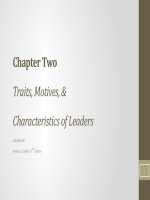Chapter 01 leadership research findings practice and skills 7th edition
Bạn đang xem bản rút gọn của tài liệu. Xem và tải ngay bản đầy đủ của tài liệu tại đây (1.2 MB, 24 trang )
Chapter One
The Nature and
Importance of Leadership
LEADERSHIP
Andrew J. DuBrin, 7th Edition
Learning Objectives
• Explain the meaning of leadership and how it differs from
management.
• Describe how leadership influences organizational performance.
• Pinpoint several important leadership roles.
• Identify the major satisfactions and frustrations associated with
the leadership role.
• Describe a framework for understanding leadership.
• Recognize how leadership skills are developed.
• Pinpoint several traits, behaviors, and attitudes of a successful
follower.
The Meaning of Leadership
• The ability to inspire confidence and support among the
people who are needed to achieve organizational goals.
• Leadership Effectiveness refers to attaining desirable outcomes
such as productivity, quality, and satisfaction in a given situation.
• Leadership Process elements include:
• Leader
• Group Members
• Context of the Situation
Leadership is a Partnership and
a Shared Responsibility
• Leadership is a partnership between leaders and group
members and thus involves a sharing of leadership
responsibility.
• The power between leaders and group members is
approximately balanced meaning this partnership occurs
when control shifts away from authoritarianism toward
shared decision making.
• Additionally, leadership often shifts depending on the
expertise needed as most relevant at the moment. What this
means is that the most senior individual on a work team is not
always the leader based on seniority.
Leadership is a Partnership and
a Shared Responsibility
• Factors necessary for a valid partnership and shared responsibility
include:
• Exchange of purpose
• A right to say no
• Joint accountability
• Absolute honesty
• The leadership role within a team is seldom the responsibility of only
one person.
• Leadership may shift, depending on whose expertise is the most
relevant at the moment.
Leadership is a Relationship
• Leadership is a relationship between the leader and the
people being led.
• “Leadership isn’t something you do to people. It’s something
you do with them.” - Ken Blanchard
• How leaders build this relationship has changed as technology
and the use of social media and email has increased.
Leadership vs. Management
MANAGEMENT:
LEADERSHIP:
• Provides order,
consistency, and
predictability
• Provides change and
adaptability
• Top-level managers
manage/maintain
organizations
• Top-level leaders transform
organizations
• Implements a vision
• Effective managers also
lead
• Creates a vision
• Effective leaders also
manage
Leaders versus Managers
Does Leadership Impact
Organizational Performance?
• Research shows leadership matters when:
• Leader is perceived to be responsible and inspirational.
• Leaders throughout the organization are involved in making decisions
and these individuals are knowledgeable about the problem to be
resolved.
• Leaders change, company performance changes.
• Statistical analysis suggests the leader might be responsible for
between 15-45 percent of a firm’s performance.
• Study findings have shown the leader’s activities have a 66 percent
probability of achieving a positive outcome in an organization’s
performance.
The Anti-Leadership Argument:
Leadership Does Not Matter
• Arguments against the importance of leadership include:
• Substitutes exist for leadership; factors in the work environment that
provide guidance and incentives to perform, make the leader’s role almost
superfluous
• Leaders can be irrelevant; people lead themselves and outside influences
can overwhelm them; factors outside the leader’s control have a larger
impact on business outcomes than do leadership actions
• Organizational systems are far too complex to attribute success to
leadership; forces outside the leader’s control determine a company’s fate
Substitutes for Leadership
• At times, competent leadership is not necessary, and incompetent
leadership can be counterbalanced by factors in the work situation.
Leadership Roles
• Figurehead
• Spokesperson
• Negotiator
• Coach and Motivator
• Team Builder
• Team Player
• Technical Problem Solver
• Entrepreneur
• Strategic Planner
• Executor
Is Leadership
Satisfying or Frustrating?
Satisfying:
• Power and prestige
• Help others grow & develop
• Increase income
Frustrating:
• Uncompensated overtime
• Too many “headaches”
• Perform – or – perish
• Insufficient authority
• Respect & status
• Loneliness
• Opportunity to advance
• Too many people problems
• “Being in on” things
• Organizational politics
• Control money & other
resources
• Pursuit of conflicting goals
• Unethical perceptions
Our Framework for
Studying Leadership
• Leadership is a function of both the leader – those being led –
and the complexity of the situational and environmental
context.
A Closer Look at Leadership
Effectiveness
• Whether or not a leader is effective depends on four sets of variables:
• Leader Characteristics & Traits –
• Leader’s inner qualities that help the leader function effectively in many situations
• Examples include self-confidence and problem-solving ability
• Leader Behavior & Style –
• Activities the leader engages in, including his/her characteristic approach
• Examples include participative leadership, task-orientation behavior
• Group Member Characteristics –
• Attributes of the group members
• Examples include their intelligence and high level of motivation assist the leader with doing an
outstanding job
• Internal & External Environment –
• Elements/forces of the situation that may or may not be within the leader’s control
• Examples include economy, diversity of workforce, organizational culture
Skill Development in Leadership
• Studying the textbook assists with developing your personal
leadership skills through the following textbook elements:
• Conceptual information and behavioral guidelines
• Conceptual information demonstrated by examples and brief
descriptions of leaders in action
• Experiential exercises
• Feedback on skill utilization, or performance, from others
• Practice in natural settings
Followership: Being an
Effective Group Member
• To be an effective leader, one needs good followers.
• Leaders cannot exist without followers.
• Key Aspects of Effective Group Members:
• Types of followers (model as defined by Barbara Kellerman, Harvard
Business School)
• Personal characteristics of productive followers
• Importance of collaboration between leaders and followers
• Followers differ in their individual engagement approach to being
a group member
TYPES OF FOLLOWERS
Types of FOLLOWERS
• ISOLATES:
• Completely detached
• There to do what they must to get by and nothing more
• Alienated from the system, the group, the organization
• Silent and ignored
By default, they strengthen leaders who already have the upper hand
From “Followership” by Barbara Kellerman, Harvard Business School
Types of FOLLOWERS
• BYSTANDERS:
• Observe, but do not participate
• Make deliberate decisions to stand aside and disengage from leaders and the group dynamic
• Their withdrawal is a declaration of neutrality that amounts to support for whoever
• They do nothing even when doing something is not especially costly or especially risky
• Free riders – content to let others make the group’s decisions and do the group’s work
The fact is that followers who stand by and do nothing give other followers a bad name – to
withdraw is to cede to those who have more power, authority, & influence than do we to make
decisions.
From “Followership” by Barbara Kellerman, Harvard Business School
Types of FOLLOWERS
• PARTICIPANTS:
• Are in some way engaged
• They either clearly favor their leaders and groups and organization – OR – they
are clearly opposed
• They invest their engagement to try to have an impact
• By and large, leaders WANT followers who are participants – assuming they are
in support and not in opposition
• There are those followers who while generally supportive of their leader and of
the organization of which they are members, nevertheless go their own way
From “Followership” by Barbara Kellerman, Harvard Business School
Types of FOLLOWERS
• ACTIVISTS:
• Feel strongly about their leaders and act accordingly
• They are eager, energetic, and engaged
• They work hard either on behalf of their leaders – OR – to undermine and unseat them
• They are either a major resource or a major bane
• They care – they care a great deal
• They care about their leaders, pro or con
• They care about each other, presumably pro
• They care about the whole of which they are a part
• They can be dangerous when they are so determined to have an impact that is illconsidered or wrongheaded
• They should be watched and they should be judged
From “Followership” by Barbara Kellerman, Harvard Business School
Types of FOLLOWERS
• DIEHARDS:
• Are prepared to die if necessary for their cause, whether an individual, an idea,
or both
• Deeply devoted to their leaders – OR – ready to remove them from positions of
power, authority, and influence by any means necessary
• Defined by their dedication
• Is all-consuming – it is who you are – it determines what you do
• They are rare – fortunately
• There are only so many diehards a society can take – And, there are only so
many followers willing to play the part
Once exception is the military – subordinates follow orders – everyone, from top
to bottom, is prepared to be wounded or even killed in battle
From “Followership” by Barbara Kellerman, Harvard Business School
Summary
• Leadership is a long-term partnership and shared responsibility between leaders and
group members. When effective, leadership inspires confidence and support among
people who are needed to achieve organizational goals.
• Although some research supports the theory leaders do affect organizational
performance, the concepts of substitutes, leader irrelevance, and complexity theory
offer an alternative view.
• Leadership involves carrying out at least ten different roles.
• There are many sources of both satisfaction and frustration to leaders.
• Leadership is a function of leader characteristics and traits, leader behavior and style,
group member characteristics, and the internal and external environments.
• Leadership is multilevel, involving the individual, the small group, and the organization.
• To be an effective leader, one needs good followers.
• Followers differ in terms of their engagement to the firm’s goals.









